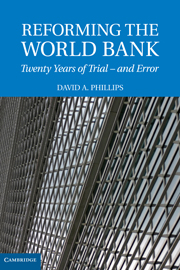Book contents
- Frontmatter
- Contents
- Preface: The Search for Effectiveness in the World's Premier Development Institution
- REFORMING THE WORLD BANK
- PART I ORIGINS AND EVOLUTION
- PART II THE SEARCH FOR EFFECTIVENESS
- PART III TOWARDS REAL REFORM: THE GOVERNANCE AGENDA
- 10 The Governors and the Directors
- 11 The Leadership
- 12 Looking Back and Looking Forward: What Is to Be Done?
- Index
12 - Looking Back and Looking Forward: What Is to Be Done?
Published online by Cambridge University Press: 25 January 2011
- Frontmatter
- Contents
- Preface: The Search for Effectiveness in the World's Premier Development Institution
- REFORMING THE WORLD BANK
- PART I ORIGINS AND EVOLUTION
- PART II THE SEARCH FOR EFFECTIVENESS
- PART III TOWARDS REAL REFORM: THE GOVERNANCE AGENDA
- 10 The Governors and the Directors
- 11 The Leadership
- 12 Looking Back and Looking Forward: What Is to Be Done?
- Index
Summary
GAINS, QUALIFIED GAINS, AND LOSSES
Over twenty years of reorganization the Bank has struggled to find a formula for organizational effectiveness. Despite continual claims of progress, it has not found it. At the beginning of this study the question was asked: Who, or what, was responsible for the debacle of the Bank reorganization? Was it poor leadership? Was it inappropriate governance? Was it the incompetence of managers and employees? Was it external pressures? Perhaps lack of skills? Did it mean that the Bank is inherently unmanageable, or did it mean that it was simply badly led? The hope is that this critique is one that will help to answer these questions and highlight the urgency of maintaining the legitimacy of a global economic development leader.
This look at twenty years of reform has mainly been about the latter half, the late 1990s and beyond, because that is when the major effort was made. The problems that James Wolfensohn undertook to solve were numerous. According to his understanding, the Bank's projects were often of doubtful quality; their impact on development was ambiguous; it was very expensive to do business with; it was increasingly bureaucratic and complex; it failed to innovate; it was too fragmented internally, too arrogant and distant from its clients; and it needed re-skilling. He had ten years in which to do something about these problems.
- Type
- Chapter
- Information
- Reforming the World BankTwenty Years of Trial - and Error, pp. 280 - 306Publisher: Cambridge University PressPrint publication year: 2009

